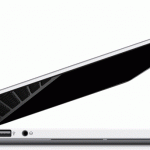 Apple has introduced another new laptop and the media is gushing – again.
Apple has introduced another new laptop and the media is gushing – again.
Just about every newspaper you pick up claims this laptop is the best ever.
Ever.
It has everything – including a hefty price tag.
Notice I am purposely omitting the model number.
That’s because I want this article to remain evergreen.
You see, every year a computer maker introduces a laptop and the press says it is the best ever.
And at the time, it is.
But next year, it will be replaced.
That’s the story of innovation in the computer industry.
Laptops get smaller, more powerful and priced just at the breaking point.
And this comes from a person who bought one of the first laptops with a built in CD-ROM for nearly $6,000 back in the day! Of course, I had a client who had CD software and I needed a computer that could demo the software.
My background is in high tech PR and I can show you hundreds of magazine covers proclaiming a certain laptop “the best ever.” Even one for a computer that NEVER actually shipped. It’s true.
So they had me hooked.
But if I add up all the money I spent on technology that I didn’t need, well, I’d be rich.
Fortunately, I didn’t upgrade every year, as some people do. In all technologies, from cameras to music to bicycles, there is an “early adopter” category that must buy everything the minute it comes out, at full price. These industries live for those buyers. That’s where the profits are. That’s how they get rewarded for their investment in research and development.
I remember a million years ago when I worked for a PR agency in New York and we handled the Sony account. I was writing the press release announcing the second generation of CD players which had an impressive list of upgrades from the first generation, including shuffle play, 16x sampling and other geeky features sure to make early adopters drool.
I mentioned to my boss, a true industry veteran, that it was impressive that Sony could improve technology so quickly. After all, the first generation of models had come out just six months before at the Consumer Electronics Show. And here we were, getting ready for the next CES and they had new models ready.
He looked at me as if I had just stepped off a Martian spaceship. “Don’t you know they could have done this six months ago?” he said. “And furthermore, they have technology that can do many more things right now.”
Like a clueless Martian, I asked “So why don’t they introduce it now?”
Again he looked at me as if he was explaining something to a five-year old, “So they can sell the new version to the early adopters. They make their money on the upsells.”
Okay. I’m a fast learner. I get it.
One thing he didn’t mention was that all the tech articles create a lust in the next level of buyer. Eventually, even the laggards buy the product, although much later in some cases. If you were the last person on your block to buy a CD player, you know who you are.
None of this is meant to criticize the tech industry or other industries with loyal fans who buy the latest and greatest product. It is perhaps a wonderful testimonial to the power of PR and marketing that can create demand, over and over, to keep an industry alive and protect the jobs it creates.
But I sure would like to have all the money I spent on digital voice recorders (from cassette to digital), video cameras (from VHS monsters weighing 10 pounds to digital devices the size of a pack of cigarettes), to printers (from dot matrix to laser to color and back to laser) and on and on.
Wouldn’t you?
What’s the worst investment you’ve made in technology?

 Save time
Save time

Leave A Comment